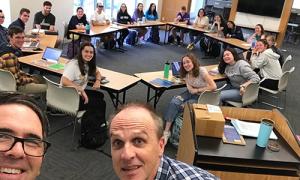Last fall, students in “History’s Mysteries,” a course taught by Professors Matthew Masur and Hugh Dubrulle, researched the 1821 murder of Goffstown resident Anna Ayer. The students in HI 112 read a variety of primary sources, including the trial record and the pre-execution final statement from the murderer, Daniel Davis Farmer. They also visited the local cemetery where Farmer is buried.
Secondary sources from the time served as important catalysts for historical understanding. The students were able to read letters to and from Daniel Farmer while he was in prison. “They also read a historical account of a different crime in Western Massachusetts from roughly the same time period. That secondary source provided a model of how historians might analyze and interpret this sort of event,” Professor Masur explained.

After researching the case, the students divided into groups and each group produced a short film recounting the murder from the perspective of one of the participants: Anna Ayer (the woman who was murdered), her daughter (also named Anna Ayer), Levi Woodbury (the judge), and Daniel Davis Farmer (the murderer). While the facts of the case remained consistent across the groups, looking at the case from different perspectives led to unique insights. “For example, the story of Anna Ayer explored the social status of a poor widow in 19th century Goffstown. The story of Levi Woodbury, the judge, described some of the legal practices and principles that shaped the trial,” said Professor Matthew Masur.
The students’ films were modeled on the “microhistories” that they read for the class. “Microhistories” are a genre of historical study that use uncommon or unusual events to reveal larger truths about the past. Students read microhistories about cases of imposture in France and New Orleans, murders in Boston and London, and the formation of a religious cult in upstate New York. In each book, a gripping and often suspenseful narrative combined with deep historical analysis.

By diving deeper into the microhistory of Anna Ayer’s murder, students gained a broader historical understanding of New Hampshire in the 1800’s. “This particular murder was interesting because it touched on so many important historical issues,” said Professor Masur. “It illustrated the social hierarchy in early America—judges like Levi Woodbury at the top; marginal figures like a widowed pauper and poor laborer at the bottom. It included details about core legal principles, like the rights of the accused and the difference between murder and manslaughter,” he explained. Other areas of discovery included the landscape, economy, transportation systems, medical practices, and views on capital punishment.
The students in “History’s Mysteries” came away with a new appreciation of the historian’s craft. They read the “finished products” of trained historians while trying their hand at their own historical research. In the words of History Major Diego Benites ’25, “I gained new insights into past societies and the people who lived there. Moreover, by surveying several different time periods and locations, the class allowed me to understand the numerous tools that historians use to examine the past.”
